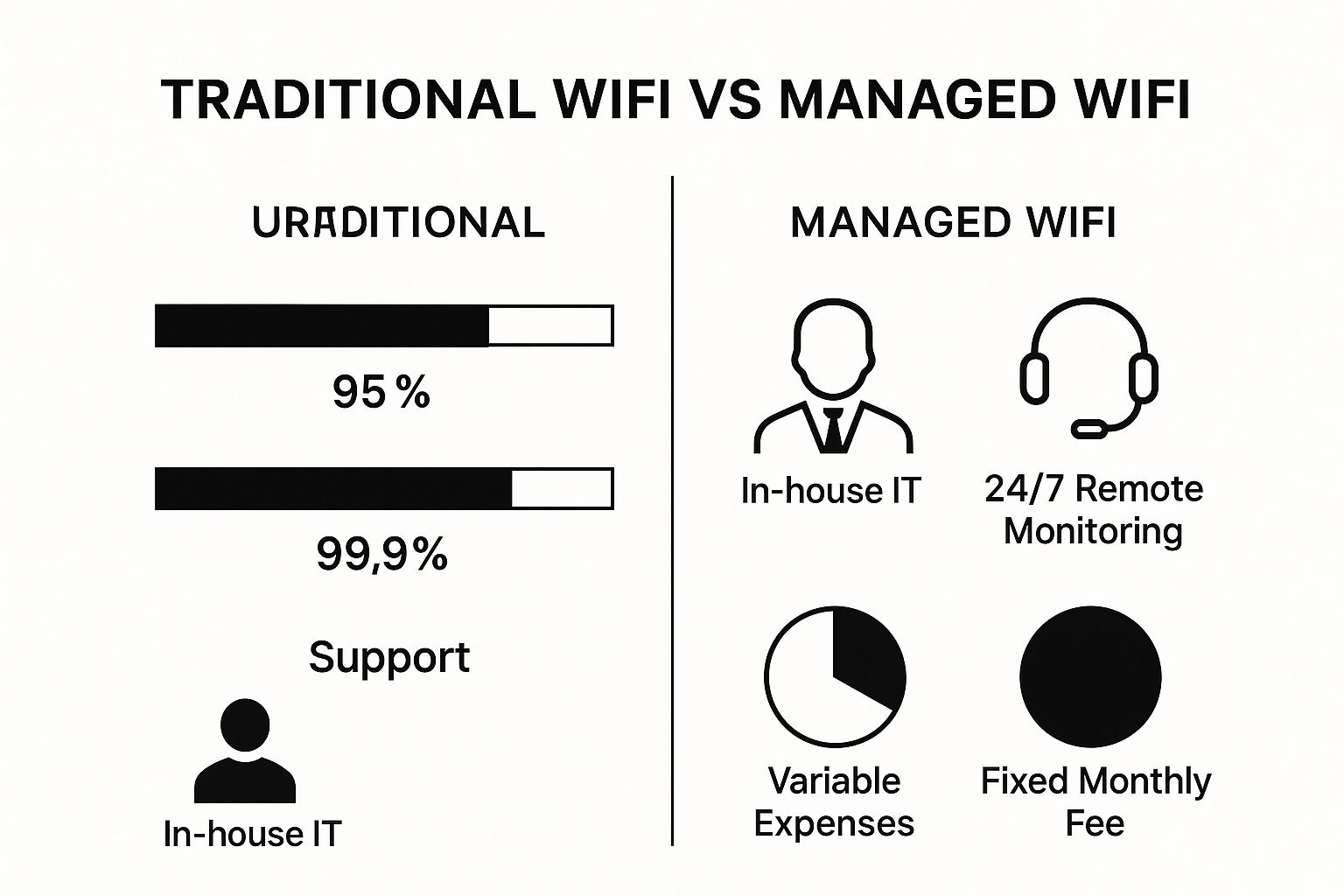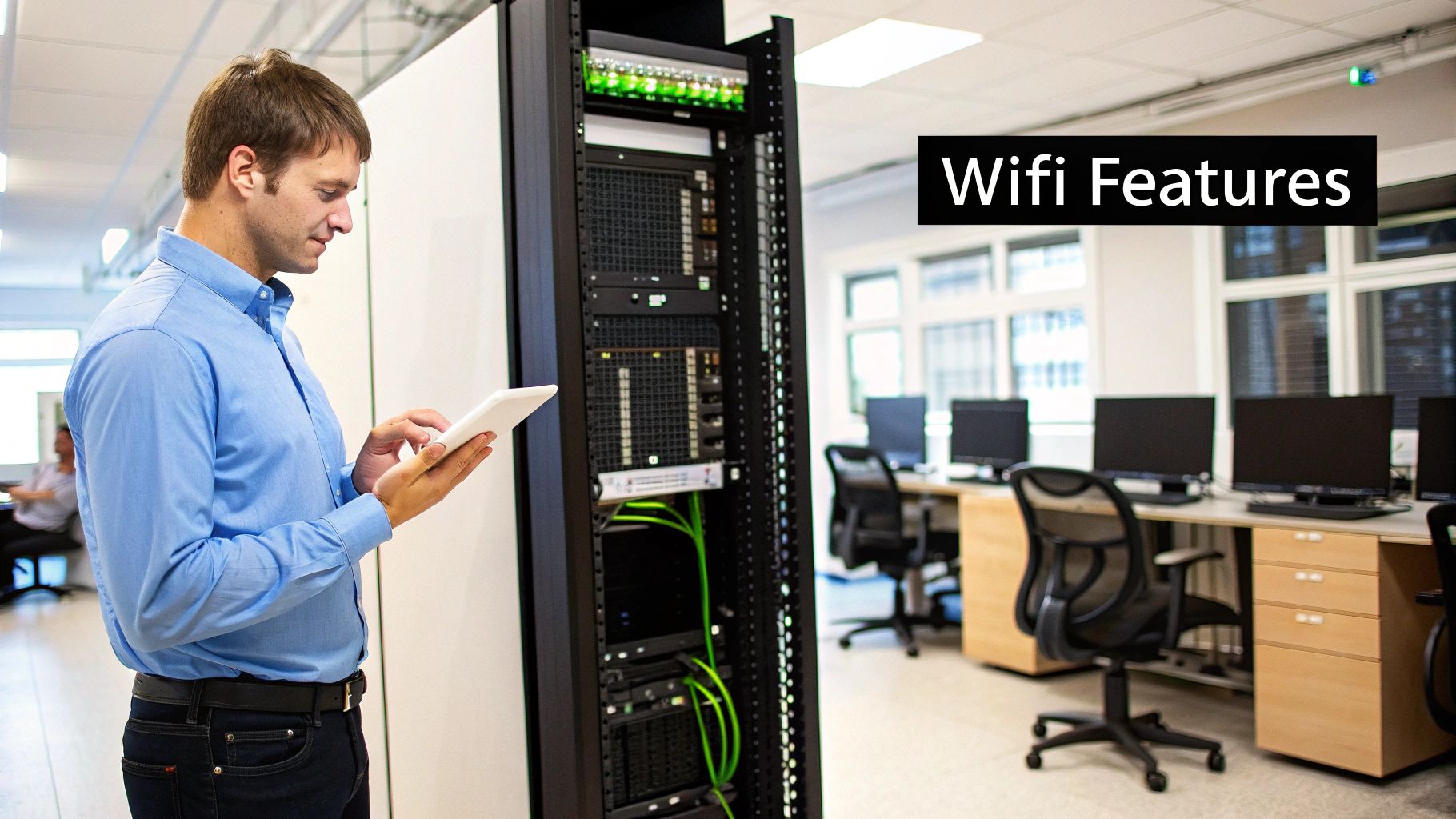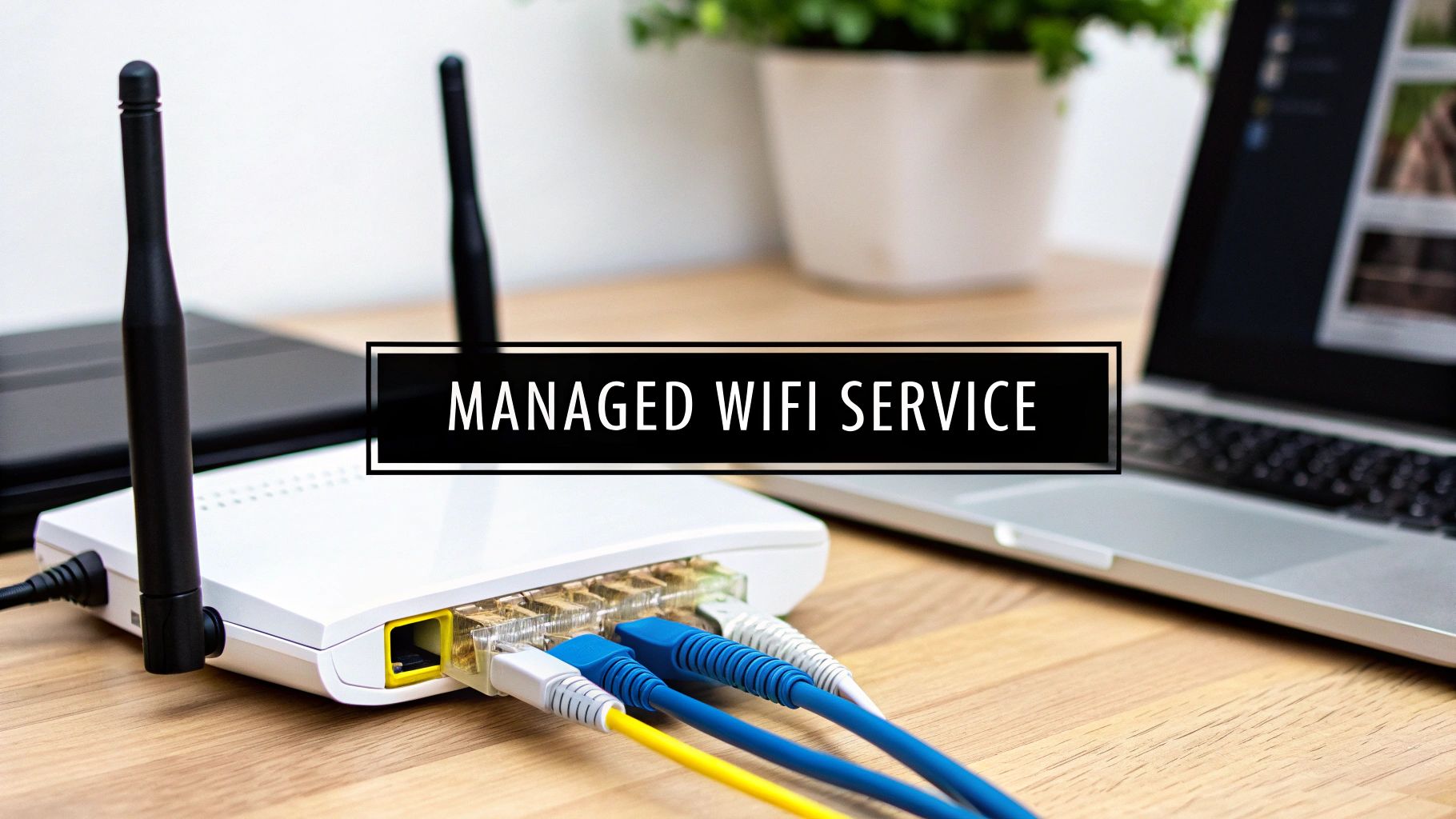Think of a managed WiFi service as having an expert pit crew for your business’s internet connection. They handle all the complex, behind-the-scenes work of network setup, security, and ongoing maintenance. Essentially, it’s a comprehensive solution where you hand over your entire wireless network management to a specialized third-party provider. The result? A rock-solid, secure connection for both your team and your guests.
What Exactly Is a Managed WiFi Service?
Let’s stick with that high-performance vehicle analogy. You could spend your time learning to be the mechanic, the engineer, and the security guard for your business WiFi. Or, you could hire a professional team that lives and breathes this stuff. A managed WiFi service is that expert team for your digital connectivity.
Instead of your internal IT staff getting bogged down with network configurations, security patches, and troubleshooting surprise outages, you outsource the entire lifecycle to specialists. This is about so much more than just getting an internet connection; it’s a full-service partnership.
This strategic move shifts your IT from a reactive, daily fire-drill into a powerful business asset. At its heart, a managed WiFi service runs on cloud-managed IT infrastructure, which is a major reason it’s so efficient and scalable. If you’re curious, you can dig into the 5 reasons why cloud-managed IT is the wave of the future to see why this model is taking over.
From Small Groups To Enterprise Scale
The demand for this kind of service has absolutely exploded. Not long ago, Wi-Fi meant a few access points covering a small office. Today, networks need to support hundreds, or even thousands, of users and their many devices without skipping a beat.
The market reflects this reality. The managed Wi-Fi solutions market was valued at $4.99 billion and is on track to hit $13.33 billion by 2031, growing at a staggering rate of over 14%. This isn’t surprising when you consider the sheer volume of smartphones, tablets, and IoT gadgets all clamoring for fast, secure connections.
To really see the difference, let’s look at a direct comparison between going it alone versus using a managed service.
In-House WiFi vs Managed WiFi Service At a Glance
The table below breaks down the key responsibilities and outcomes for each approach, offering a clear snapshot of where your time, money, and resources go.
| Aspect | In-House WiFi Management | Managed WiFi Service |
|---|---|---|
| Initial Setup & Design | Your IT team handles site surveys, hardware selection, and configuration. | Experts design and install the network for optimal coverage and performance. |
| Ongoing Monitoring | Relies on internal staff to spot and react to issues. | Proactive 24/7 monitoring by a dedicated Network Operations Center (NOC). |
| Security Management | Your team is responsible for all security protocols, updates, and compliance. | Comprehensive security suite, including firewalls and content filtering, is managed for you. |
| Costs | High upfront hardware costs (CAPEX) plus unpredictable maintenance expenses. | Predictable monthly operational cost (OPEX) with no surprise fees. |
| Support & Troubleshooting | Limited to your IT team’s availability and expertise. | Access to a dedicated team of experts around the clock for fast problem resolution. |
| Hardware Upgrades | Budgeting and planning for hardware lifecycle falls on your company. | All hardware is kept current and replaced as part of the service fee. |
As you can see, the managed route is designed for predictability, expertise, and peace of mind, letting you focus on your core business instead of your network infrastructure.

The data really speaks for itself. A managed approach consistently delivers better uptime and always-on support for a predictable cost, a stark contrast to the fluctuating and often hidden expenses of managing WiFi in-house.
The Core Components Of Service
So, what are you actually getting? A true managed WiFi service is a bundle of ongoing support and professional expertise. It almost always includes:
- Professional Design and Installation: Experts come on-site to conduct surveys, mapping out the best placement for access points to guarantee you have strong coverage everywhere, with no frustrating dead zones.
- Proactive 24/7 Monitoring: The provider’s Network Operations Center (NOC) is constantly watching your network. They’re looking for performance dips or security threats, and they often fix problems before you or your users even notice something is wrong.
- Comprehensive Security Management: This is a big one. It includes setting up secure guest networks, deploying enterprise-grade firewalls, filtering unwanted content, and ensuring your network meets compliance standards like HIPAA or PCI.
- Hardware Lifecycle Management: Your provider makes sure all your network gear—like access points and switches—is kept up-to-date. They handle replacements before the hardware becomes slow or obsolete, so you’re always running on modern equipment.
You can learn more about how these different pieces come together to create a powerful, seamless network in our complete guide to https://clouddle.com/blog/managed-wifi-services/.
The Real-World Business Impact of Managed WiFi

It’s one thing to understand the technical side of a managed WiFi service, but it’s another thing entirely to see how it directly impacts your daily operations and, ultimately, your bottom line. This isn’t just another IT upgrade. Think of it as a strategic investment that delivers tangible returns in cost savings, security, and overall efficiency.
One of the most immediate perks is how it changes your spending. Instead of a huge upfront cost for enterprise-grade routers, access points, and switches, you move to a predictable monthly subscription. This approach often completely removes the need for a dedicated—and expensive—in-house network team to handle it all.
From Cost Center to Strategic Advantage
Handing off your network management to experts doesn’t just put a lid on costs; it frees up your internal IT team. Instead of constantly troubleshooting connectivity issues, they can focus their talent on projects that actually move the needle for your business. It’s a simple shift that can turn a reactive IT department into a proactive force for growth.
Think about all the hidden costs of managing your own network. It’s not just about the hardware and salaries. You also have to factor in software licenses, continuous training, and the biggest drain of all: downtime. A managed WiFi service smooths out these financial bumps, giving you a clear, predictable cost model that makes budgeting a breeze and boosts your return on investment.
Key Insight: A managed network flips the script, turning unpredictable capital expenses (CAPEX) into a stable operational expense (OPEX). This financial predictability allows for smarter resource allocation and shields your business from the crippling costs of network downtime and security breaches, which can easily climb into thousands of dollars per hour.
Fortifying Your Digital Defenses
With cyber threats lurking around every corner, rock-solid security isn’t just a nice-to-have; it’s essential. A managed WiFi provider is like having a specialized cybersecurity squad on your side, implementing top-tier security protocols that are often too complex or expensive for a single business to handle alone. They manage everything from advanced firewalls to sophisticated intrusion detection systems.
This proactive approach to security does more than just safeguard your data—it also makes staying compliant much simpler. If you’re in healthcare (HIPAA) or retail (PCI DSS), you know that meeting strict regulatory standards is a constant, complicated job. A good managed service provider shoulders that burden, ensuring your network is not only secure but also fully compliant.
Boosting Productivity and Customer Satisfaction
A strong, reliable network has a direct, measurable effect on performance. For your team, a stable and speedy connection means less time staring at loading screens and more time getting things done. In fact, studies have shown that poor internet connectivity can cost an employee up to a full week of productivity each year. A managed service makes sure that lost time doesn’t happen on your watch.
This performance boost extends right to your customers. Picture a retail shop where the guest WiFi is fast, secure, and easy to access, encouraging shoppers to browse longer. Or a hotel where guests can stream movies without a single hiccup, leading to glowing reviews and repeat bookings. In these cases, the managed wifi service isn’t just providing internet access—it’s actively improving the customer experience, which is a direct line to greater satisfaction and loyalty.
What’s Actually Included in a Top-Tier Managed Wi-Fi Service?

When you partner with a managed Wi-Fi provider, you’re getting far more than just an internet connection. You’re bringing on a team of specialists whose entire job is to keep your network running flawlessly so you can focus on yours.
Let’s break down the core features that truly separate a professionally managed service from a standard, do-it-yourself setup.
Proactive 24/7 Network Monitoring
The biggest game-changer is proactive 24/7 monitoring. Imagine having a dedicated team at a Network Operations Center (NOC) keeping a constant eye on your Wi-Fi’s health. Using advanced tools, they spot performance drops, security risks, and potential hardware failures long before they turn into real problems.
This constant watchfulness means issues get fixed before your staff or customers ever notice a slowdown. It completely flips the script from the old, reactive “break-fix” model to a strategy that keeps you online and productive.
Robust Security Management
In today’s world, strong cybersecurity isn’t optional. A quality managed Wi-Fi service essentially becomes your dedicated security team, building and maintaining a defense system that’s much more than just a strong password.
Think of it as a multi-layered security detail for your data. Key components usually include:
- Enterprise-Grade Firewalls: This is your digital bouncer, blocking malicious traffic and unauthorized access attempts at the front door.
- Intrusion Detection Systems (IDS): These systems actively scan network traffic for any suspicious activity or known threats, acting like security cameras for your data.
- Secure Guest Access Portals: You can offer Wi-Fi to visitors without giving them the keys to your internal network. It’s a separate, sandboxed connection that protects your sensitive business data.
- Automated Security Updates: The provider ensures every piece of your network hardware is consistently patched against the latest vulnerabilities, closing security holes as soon as they’re discovered.
The need for this level of security is a major reason the managed Wi-Fi market is now projected to hit $7.53 billion. As data protection rules get stricter, businesses are turning to experts to handle the complexity. You can dive deeper into this trend with industry analysis from ResearchAndMarkets.com.
Professional Installation and Hardware Lifecycle
A reliable network has to be built on a solid foundation. Your provider will start with a detailed site survey, mapping out your entire physical space to determine the perfect placement for every access point. This methodical approach is how they eliminate dead zones and guarantee you get strong, seamless coverage everywhere you need it.
Better yet, they handle the entire hardware lifecycle. You’ll never have to worry about your equipment becoming slow, obsolete, or failing unexpectedly.
Your Performance Guarantee: The Service Level Agreement (SLA)
The SLA is the most important part of your contract. It’s a legally binding document that spells out exactly what you can expect, defining concrete metrics for network uptime, support response times, and how quickly issues will be resolved. It holds your provider accountable and ensures you get the high-quality, reliable service you’re paying for.
This powerful combination of around-the-clock monitoring, expert security, professional setup, and guaranteed performance is what makes a managed Wi-Fi solution so valuable.
How Different Industries Gain a Competitive Edge
To really grasp what a managed Wi-Fi service can do, it helps to step away from the technical specs and look at how it plays out in the real world. This isn’t just about providing an internet connection; it’s a strategic tool that businesses in different sectors are using to solve unique problems and get ahead.
Think about the hospitality industry, where guest experience is the name of the game. A hotel with a top-notch managed Wi-Fi service can deliver seamless connectivity everywhere, from the front desk to the farthest poolside cabana. This simple upgrade helps them dodge the kind of bad reviews that a spotty connection almost always creates. They can also dig into network analytics to see how guests move around the property, which opens the door to personalized offers that make a stay more memorable and build loyalty.
This kind of industry-specific thinking is exactly why the market is growing so quickly. The global managed Wi-Fi solution market was valued at around $7.03 billion and is expected to hit $16.86 billion by 2033. By handing off these complex networking headaches, businesses of all stripes can boost their performance without letting costs spiral out of control. You can see a full breakdown of this trend in a report on managed WiFi solutions.
Tailored Solutions for Diverse Needs
The benefits really crystallize when you see how different businesses adapt the technology to meet their core objectives.
- Retail Stores: In a bustling shop, managed Wi-Fi is the invisible engine keeping everything running. It provides a rock-solid connection for critical systems like Point-of-Sale (POS) terminals and inventory scanners. At the same time, it can offer a secure guest network that collects valuable, anonymous data on foot traffic and dwell times, giving managers the insights they need to perfect the store layout.
- Healthcare Facilities: For hospitals and clinics, security and reliability are non-negotiable. Managed Wi-Fi creates ultra-secure, segmented networks to shield sensitive patient data (EHR) and keep critical medical devices online, all while adhering to strict HIPAA compliance.
This whole approach is a key part of a bigger idea called Network as a Service (NaaS). If you’re curious about the broader concept, you can learn more in our guide on managed network as a service and what you need to know.
Supporting Modern Work and Large Venues
Corporate offices and sprawling campuses are also seeing massive benefits. The shift to hybrid work and the explosion of Internet of Things (IoT) devices have made managing an internal network more complex than ever before.
A managed WiFi service ensures that a large corporate campus can support thousands of devices—from employee laptops to smart building sensors—without performance degradation. It provides the stable, secure backbone needed for video conferencing, cloud applications, and collaboration tools that are essential for today’s workforce.
These real-world examples make it clear that a managed solution is far more than just another IT line item. It’s a smart investment that can spark innovation, tighten security, and create a better, smoother experience for both employees and customers, no matter what business you’re in.
Choosing the Right Managed WiFi Partner

Picking a managed Wi-Fi provider isn’t like buying a utility; it’s more like finding a long-term business partner. The right one will feel like a natural extension of your team, taking a huge weight off your shoulders. The wrong one? They can become a source of constant frustration.
Making a smart choice here is absolutely critical. It’s the difference between a reliable, secure network that fuels your business and one that holds you back.
A great place to start is with industry experience. A provider who specializes in hotels and resorts will deeply understand the challenges of guest access and high-density spaces. On the other hand, one with a background in healthcare will be a pro at HIPAA compliance and keeping sensitive medical devices secure. Always ask for case studies or references from businesses like yours.
Evaluating Service and Support
This is where the real differences between providers shine through. Almost everyone promises 24/7 support, but you need to dig into what that actually means in practice. A provider’s commitment to established IT support best practices is a powerful clue about their quality and reliability.
A truly great partner doesn’t just sit around waiting for your call when something goes wrong. They’re proactive, often identifying and fixing problems before you or your team even notice them.
This is why the Service Level Agreement (SLA) is your most important document. A vague or weak SLA is a massive red flag.
Key Takeaway: A strong SLA is your contractual guarantee. It needs to clearly define uptime percentages—aim for 99.9% or higher—and spell out specific response times for different issues. If a provider won’t commit to firm numbers in writing, it’s a good sign to look elsewhere.
This document turns their sales promises into accountable performance standards, giving you both peace of mind and a clear path forward if service ever slips.
Key Questions for Potential Providers
Before you even think about signing a contract, you need to ask some tough, specific questions. Creating a checklist helps you cover all your bases and compare different providers on an even playing field. This whole process is crucial, and for more general advice, our article on how to choose a managed service provider provides a helpful framework.
Make sure you have these questions ready during your evaluations:
- Security Architecture: How exactly do you separate guest traffic from our internal business network? What can you tell me about your firewall, intrusion detection systems, and content filtering?
- Hardware Standards: What specific brands and models of access points, switches, and other gear do you use? What’s your policy for upgrading hardware as it ages?
- Scalability and Growth: If we need to add more access points or expand to a new location, what does that process look like? How do you keep performance strong as we add more people and devices?
- Reporting and Analytics: What kind of dashboards and reports will we get? Can we see real-time network health, how devices are being used, and any security alerts?
A transparent, confident provider will welcome these questions and give you clear, detailed answers. Be cautious of anyone whose main selling point is just a low price. That often means they’re cutting corners on support, hardware quality, or security. Your goal isn’t the cheapest bid; it’s the partner who delivers the most undeniable value.
Of course. Here is the rewritten section, focusing on a natural, expert tone while preserving all the original information, links, and formatting.
Common Questions About Managed WiFi
Even with all the benefits laid out, it’s natural to have a few lingering questions. Let’s tackle some of the most common concerns we hear from business owners to make sure you have a crystal-clear picture of what a managed WiFi service really involves.
Is Managed WiFi More Expensive Than Handling It In-House?
This is probably the number one question people ask, and the answer can be surprising. While you do have a predictable monthly fee, a managed service is often significantly more cost-effective when you look at the total picture.
First, you completely sidestep the massive upfront cost of buying enterprise-grade hardware, which can easily climb into the thousands. More importantly, you remove the hidden, ongoing expenses: salaries for specialized IT staff, constant software licensing, and the unpredictable costs of downtime or a security breach. Once you add it all up—hardware, staff time, and lost revenue during an outage—that fixed monthly fee often delivers a far better return on your investment.
Key Consideration: A managed solution fundamentally changes how you pay for your network. It shifts the cost from a large, unpredictable capital expense (CapEx) to a stable, manageable operational expense (OpEx). This makes budgeting much easier and protects you from sudden financial hits.
How Secure Is a Network From a Managed Provider?
Security is arguably one of the biggest wins you get with a managed service. A reputable provider lives and breathes network security. They implement enterprise-level protections that are frankly out of reach for most small and mid-sized businesses to handle on their own.
Think of them as your dedicated digital security team. They build a multi-layered defense system that typically includes:
- Advanced Firewalls: The first line of defense, acting as a gatekeeper to filter out malicious traffic before it ever reaches your network.
- Intrusion Prevention Systems: These systems don’t just sit there; they actively hunt for suspicious activity and neutralize threats in real-time.
- Secure Guest Portals: This is crucial. It gives visitors a separate, firewalled network, completely isolating them from your sensitive internal business data.
- Continuous Updates: They are constantly patching all your network equipment to protect against the latest security vulnerabilities as soon as they’re discovered.
A good provider also ensures your network is compliant with standards like PCI DSS or HIPAA, giving you a much stronger security posture than any off-the-shelf setup ever could.
What Happens When The WiFi Goes Down?
This is where your Service Level Agreement (SLA) becomes your best friend. Your provider is monitoring your network 24/7/365, with the goal of catching and fixing problems before you even notice them.
If something does go wrong, their systems instantly alert a team of engineers who start troubleshooting immediately—often resolving the issue before your staff is even aware there was a problem. The SLA is their contractual promise to you for uptime and rapid response. So instead of your team scrambling to figure out what’s wrong, you have experts already on the case, working to get you back online as fast as possible.
Do I Have to Switch My Internet Provider?
Nope. In almost every situation, you can keep your current Internet Service Provider (ISP). Your ISP is responsible for one thing: getting the internet connection to your building. That’s where their job ends.
The managed WiFi provider picks up from there. They take the internet connection you’re already paying for and professionally design, deploy, and manage the wireless network inside your building. Their expertise is in making sure that internet bandwidth is distributed perfectly, giving every employee, guest, and device a fast, reliable, and secure connection.
Ready to transform your business’s connectivity with a reliable, secure, and fully managed network? The team at Clouddle Inc has decades of experience designing and deploying high-performance WiFi solutions for businesses just like yours. Discover how our Network-as-a-Service offering can eliminate your IT headaches and create exceptional experiences for your guests and staff. Learn more about Clouddle’s managed technology solutions today.


